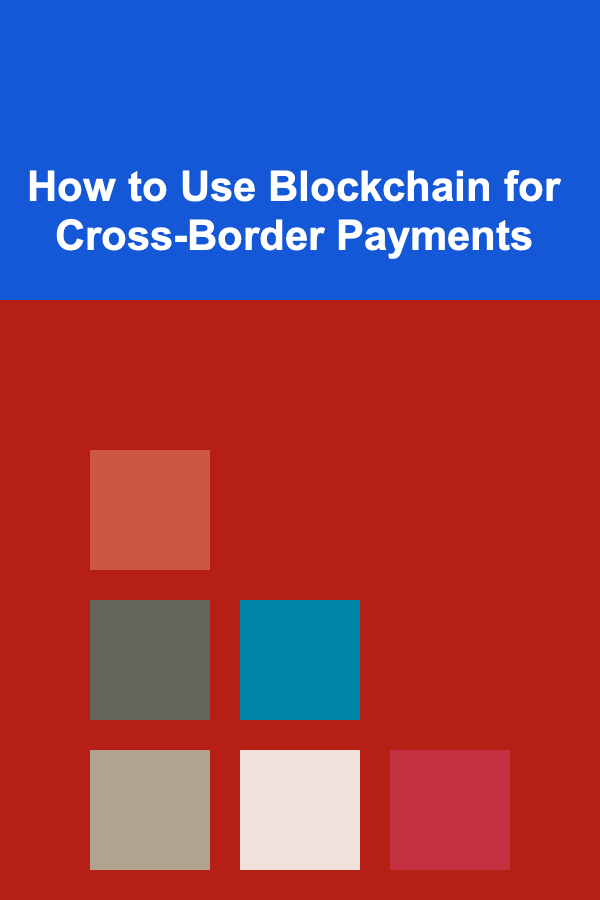
How to Use Blockchain for Cross-Border Payments
ebook include PDF & Audio bundle (Micro Guide)
$12.99$5.99
Limited Time Offer! Order within the next:

Blockchain technology has the potential to revolutionize many aspects of the financial industry, with one of the most prominent use cases being cross-border payments. Traditional methods of making international payments have long been fraught with inefficiencies, high costs, and delays. Blockchain presents a decentralized, secure, and efficient alternative that can address these issues and reshape the way money moves across borders. In this article, we will delve deeply into how blockchain can be used for cross-border payments, exploring its benefits, challenges, and the technologies behind it.
Understanding Cross-Border Payments
Cross-border payments are transactions where the payer and the payee are located in different countries. These payments are commonly used for international trade, remittances, and investment transfers. Traditionally, cross-border payments have been facilitated by banks and intermediaries such as correspondent banks, which maintain accounts in different countries to transfer money between them.
However, this traditional system has several shortcomings:
- High Costs: Intermediaries, such as banks and payment processors, charge significant fees for processing cross-border payments. These fees are often passed on to the sender and recipient, increasing the overall cost of the transaction.
- Delays: Cross-border payments can take several days to process, especially when they involve multiple intermediaries. The time delay is often due to time zone differences, bank working hours, and the need to verify transactions.
- Lack of Transparency: Due to the involvement of multiple intermediaries, the sender and receiver often have little visibility into the status of the payment.
- Currency Conversion: Cross-border payments typically involve currency conversions, which can result in additional fees and unfavorable exchange rates.
Blockchain, with its decentralized ledger and transparent architecture, has emerged as a powerful tool to solve these problems.
How Blockchain Works in Cross-Border Payments
The Basics of Blockchain Technology
Blockchain is a distributed digital ledger that records transactions in a secure, transparent, and immutable way. Each block in the chain contains a list of transactions, and once added to the blockchain, it cannot be altered. The decentralized nature of blockchain means that no single entity controls the network; instead, it relies on a consensus mechanism among participants.
In the context of cross-border payments, blockchain offers several key advantages:
- Decentralization: Blockchain eliminates the need for intermediaries by providing a direct peer-to-peer network for transactions. This reduces the costs and inefficiencies associated with traditional banking systems.
- Security: Transactions on a blockchain are cryptographically secured, ensuring that they are tamper-proof and resistant to fraud. The use of public and private keys adds an additional layer of security to the system.
- Transparency: All transactions are recorded on the blockchain, providing a transparent and auditable history of payments. This transparency helps to build trust between parties and reduce the risk of fraud.
- Speed: Blockchain transactions can be processed in real-time or within a few minutes, significantly reducing the time it takes to complete cross-border payments.
Using Cryptocurrency for Cross-Border Payments
Cryptocurrencies, such as Bitcoin and Ethereum, are the most well-known use cases of blockchain technology. These digital currencies operate on public blockchains, enabling instant and cost-effective cross-border payments without the need for traditional intermediaries.
For example, a person in the United States can send Bitcoin to a recipient in Japan, and the transaction can be verified on the blockchain within minutes. The recipient can then choose to convert the Bitcoin into Japanese yen or use it directly for other transactions. This process bypasses the traditional banking system and avoids high fees and delays.
Stablecoins and Their Role in Cross-Border Payments
While cryptocurrencies like Bitcoin offer advantages in terms of speed and security, their price volatility can make them less suitable for everyday transactions, particularly in the context of cross-border payments. A single Bitcoin's value can fluctuate significantly in a short period, which could make it difficult for both senders and receivers to predict the exact amount they will receive.
This is where stablecoins come in. Stablecoins are cryptocurrencies that are pegged to a stable asset, such as the US dollar or gold. They are designed to maintain a stable value, making them ideal for cross-border payments.
For example, Tether (USDT) is a stablecoin that is pegged 1:1 to the US dollar. A person in India can send USDT to a recipient in Brazil, and the recipient will receive a stable amount of value in Brazilian reais (BRL) once the stablecoin is converted. This eliminates the risk of price fluctuations and provides a predictable transaction amount.
Advantages of Blockchain for Cross-Border Payments
1. Lower Transaction Costs
Traditional cross-border payments often incur significant fees due to the involvement of multiple intermediaries. These intermediaries charge processing fees, currency conversion fees, and other hidden costs. Blockchain eliminates the need for intermediaries, which can significantly reduce transaction fees.
For instance, companies like Ripple (XRP) have developed blockchain-based solutions for cross-border payments that can settle transactions at a fraction of the cost of traditional methods. Ripple's blockchain network connects financial institutions globally and enables real-time, low-cost transfers.
2. Faster Transactions
Traditional cross-border payments can take several days to process, especially if they involve multiple intermediaries. Blockchain transactions, on the other hand, can be completed in minutes or even seconds, regardless of the geographical locations of the parties involved.
For example, a company in the United States can send a payment to a supplier in China using Ripple's XRP ledger. The transaction will be settled in seconds, whereas traditional wire transfers could take several days to process.
3. Increased Transparency
Blockchain provides full transparency regarding transaction history. Every payment made on a blockchain is publicly recorded, and both the sender and recipient can track the transaction in real-time. This transparency enhances trust between parties and reduces the likelihood of fraud.
Additionally, businesses and regulators can use blockchain's immutable ledger to audit transactions and ensure compliance with financial regulations.
4. Enhanced Security
Blockchain transactions are secured using cryptographic algorithms, making them highly resistant to fraud and hacking. Since the blockchain is decentralized and distributed across multiple nodes, it is virtually impossible for any single entity to alter the transaction data. This provides a higher level of security compared to traditional payment systems, which are often vulnerable to cyber-attacks and fraud.
Moreover, the use of public and private keys ensures that only authorized parties can initiate and access the payment. This added security makes blockchain a trusted method for cross-border payments.
5. Elimination of Currency Conversion Issues
One of the challenges of cross-border payments is the need for currency conversion. When sending money across borders, the sender often has to deal with unfavorable exchange rates and high conversion fees. Blockchain technology, particularly stablecoins, can eliminate the need for currency conversion by allowing payments to be made in a digital asset that is already pegged to the desired currency.
For example, if a person in Mexico wants to send money to a recipient in the European Union, they could use a stablecoin like USDC, which is pegged to the US dollar. The recipient can then easily convert the stablecoin into euros, avoiding the high fees and poor exchange rates typically associated with currency conversion.
Challenges of Using Blockchain for Cross-Border Payments
While blockchain presents numerous advantages for cross-border payments, there are also several challenges that need to be addressed.
1. Regulatory Uncertainty
The regulatory landscape surrounding blockchain technology and cryptocurrencies is still evolving. Different countries have different rules and regulations regarding the use of cryptocurrencies, and this regulatory uncertainty can make it difficult for businesses to adopt blockchain-based payment systems.
For example, some countries, such as China, have imposed strict regulations on cryptocurrency usage, while others, such as El Salvador, have embraced Bitcoin as legal tender. This lack of uniformity creates challenges for businesses looking to use blockchain for cross-border payments, as they may face regulatory hurdles in certain jurisdictions.
2. Scalability Issues
Blockchain networks, particularly those that rely on Proof-of-Work consensus mechanisms like Bitcoin and Ethereum, can face scalability issues. As the number of transactions on the network increases, the blockchain can become congested, leading to slower transaction times and higher fees.
While newer blockchain networks, such as Solana and Polkadot, offer higher scalability and faster transaction speeds, scalability remains a challenge for some of the more established blockchain networks.
3. Volatility of Cryptocurrencies
Cryptocurrencies, such as Bitcoin and Ethereum, are known for their price volatility. This can create challenges for businesses and individuals looking to make cross-border payments, as the value of the asset could change significantly between the time the payment is sent and the time it is received.
Stablecoins, which are pegged to a stable asset, have mitigated this issue to some extent, but the volatility of cryptocurrencies remains a concern for many users.
4. Lack of Awareness and Adoption
While blockchain has gained significant attention in recent years, many people are still unfamiliar with the technology and how it works. This lack of awareness and understanding can hinder the widespread adoption of blockchain for cross-border payments.
For businesses and individuals to fully embrace blockchain-based payment systems, there needs to be greater education and awareness about the benefits and risks of the technology.
Conclusion
Blockchain technology has the potential to revolutionize cross-border payments by offering lower costs, faster transaction times, enhanced security, and greater transparency. By eliminating intermediaries and providing a decentralized, secure platform for transferring funds, blockchain is poised to streamline the global payments ecosystem.
Despite its many advantages, there are challenges, including regulatory uncertainty, scalability issues, and the volatility of cryptocurrencies. However, with continued innovation and development, these challenges can be addressed, and blockchain can become the foundation for a more efficient, inclusive, and transparent global payments system.
As blockchain technology continues to evolve, it will likely play an increasingly central role in transforming the financial landscape, especially for cross-border payments.

Becoming a Data Analyst: A Step-by-Step Approach to Data-Driven Success
Read More
How to Design an Entryway that Reflects Your Personal Style
Read More
How to Establish a Healthy Feeding Routine for Your Pet
Read More
How to Prepare a Weekly Meal Plan Using Organized Recipes
Read More
Mastering Public Health: Essential Skills for Effective Health Promotion
Read More
How To Understand How Sleep Impacts Brain Performance
Read MoreOther Products

Becoming a Data Analyst: A Step-by-Step Approach to Data-Driven Success
Read More
How to Design an Entryway that Reflects Your Personal Style
Read More
How to Establish a Healthy Feeding Routine for Your Pet
Read More
How to Prepare a Weekly Meal Plan Using Organized Recipes
Read More
Mastering Public Health: Essential Skills for Effective Health Promotion
Read More